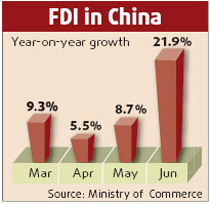China is likely to become the third biggest importer of goods from the United States within a year after five straight years as the fastest growing US export market.
Chinese Vice Minister of Commerce Gao Hucheng said on Thursday that China was expected to overtake Japan as the third largest US export market at the end of this year or early next year.
China's foreign trade volume reached US$ 1.17 trillion in the first seven months of 2007, an increase of 24.4 percent over the same period last year, according to customs sources.
The European Union remained its largest partner with a trade value of US$ 190.1 billion, a growth of 28.5 percent over the same period of last year, followed by the United States with US$ 167 billion, up 17.5 percent, and Japan with US$ 130 billion, up 15.2 percent.
Trade between China and the US reached US$ 262.7 billion in 2006 compared with US$ 2.5 billion in 1979 with farm produce and machinery registering fast growth, said Gao.
China stood as the ninth largest export market of the US in 2001 and the fourth largest in 2005, while Canada was the largest in 2006, followed by Mexico and Japan.
The US began to see a trade deficit with China in 1983. In 1991, China overtook Japan and became the second largest source of US trade deficit. Since 2000, China had become the largest source of US trade deficit, said Zhang Yansheng, director of the International Economic Research Institute under the National Development and Reform Commission.
Zhang said China's rocketing trade surplus unsettling the US, which keeps pressing China to ease currency controls and import barriers.
Official figures show China's trade surplus with the United States jumped by 22 times from 1993 to 2006 when it hit US$ 144.2 billion.
In the first seven months of 2007, China's exports to the US topped US$ 127.65 billion while imports from the U.S. reached US$ 39.35 billion, according to official figures.
"Trade between China and the United States is beneficial to both sides. The US generally imports what it doesn't produce from China, which means these imports will in no way compete with US-made products," said Assistant Minister of Commerce Wang Chao.
He said if the US abandoned Chinese goods, imports from other countries may be more expansive.
US consumers saved more than US$ 600 billion by buying products made by China in the last ten years, said Gao.
Research by the US-China Business Council shows bilateral trade cooperation is expected to add US$ 1,000 to the disposable income of each US family in 2010.
The unbalanced China-US trade was also the result of US restrictions on exports of high-tech products to China and the global manufacturing transfer from developed to developing countries, Wang said.
His opinion echoed Chinese Vice Premier Wu Yi, who, on May 24 during a visit to the US, called for efforts from the United States to improve the trade imbalance between the two countries, saying China's efforts alone were not enough to achieve the goal.
The US trade deficit was the result of multifaceted and complicated factors, but "we believe it is mainly of a shifted and structural nature and is related to US export control against China", she said.
From 2001 to 2006, the proportion of US high-tech exports to China's aggregate high-tech imports decreased from 18.3 percent to 9.1 percent. If that ratio was kept at 18.3 percent, US exports to China would have increased by at least US$ 70 billion, according to the vice premier.
She said export control applied by the United States against China had constrained exports of internationally competitive US high-technology products to China.
"China has seen a trade surplus with the United States in its manufacturing sector, but there are deficits in its primary and tertiary sectors," said Wang.
By 2006, the United States had set up more than 50,000 enterprises in China with investment totaling more than US$ 54 billion while China had established more than 1,100 enterprises in the United States with investment of nearly US$ 3 billion, Gao said.
(Xinhua News Agency August 24 2007)


